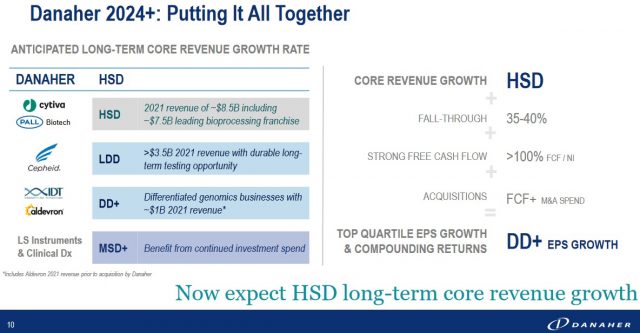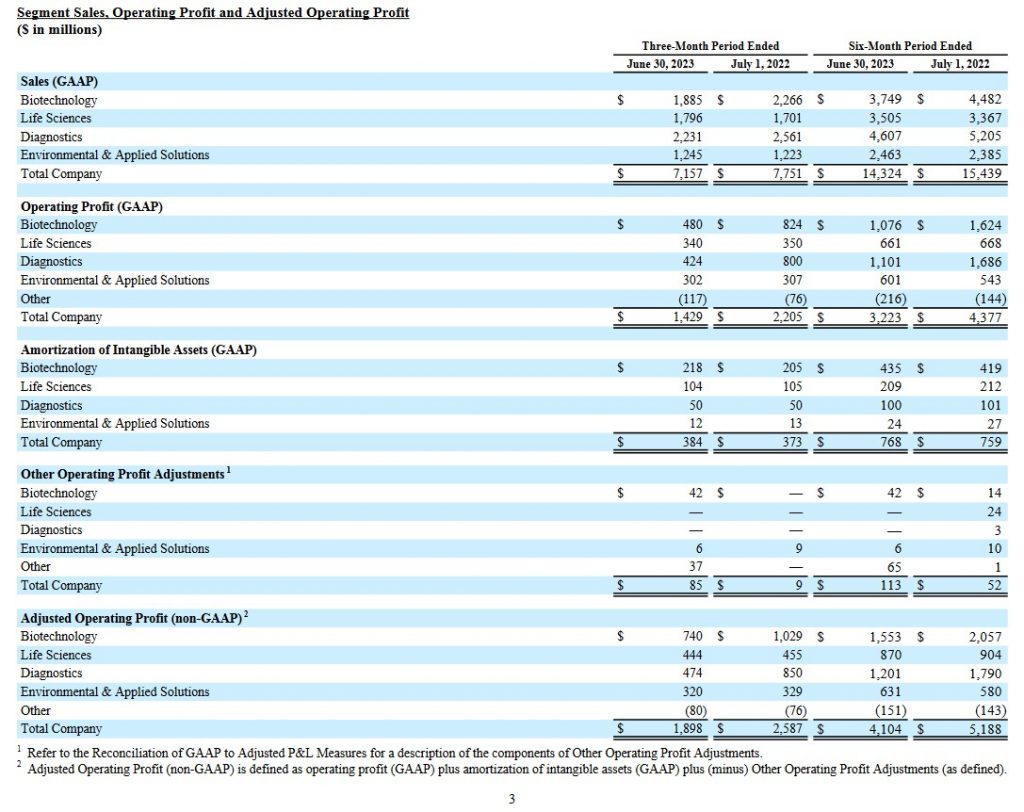Contents
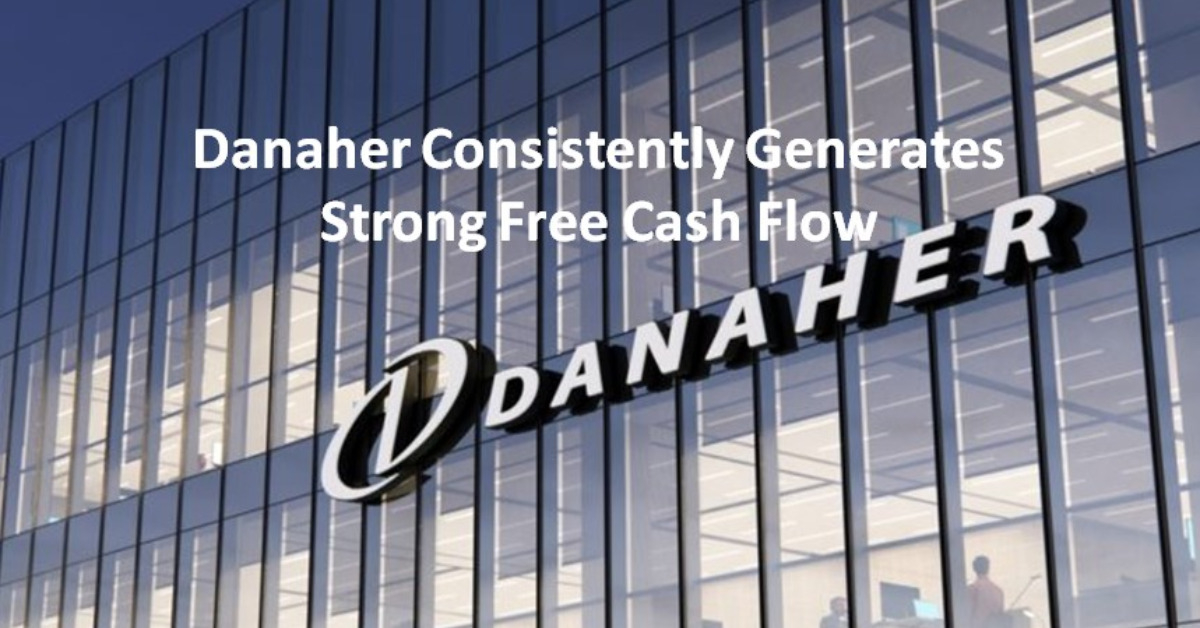
I last reviewed Danaher (DHR) in this October 21, 2022 post at which time I held 285 DHR shares in a 'Core' account in the FFJ Portfolio. In a brief January 6, 2023 post, I disclose the purchase of an additional 50 shares @ ~$246.18/share thereby increasing my exposure to 335 shares.
I subsequently acquired:
- 60 shares @ $240.62 on April 25; and
- 50 shares @ $234.36 on July 6
thereby increasing my DHR exposure to 445 shares in a 'Core' account in the FFJ Portfolio. I did not, however, publish a post in conjunction with these 2 purchases and merely disclosed these purchases in my monthly portfolio reports.
Now that DHR has released its Q2 and YTD2023 results, I revisit this holding to determine if I should increase my exposure.
Overview
I have provided an overview of DHR in previous posts that are accessible through the FFJ Archives. Furthermore, if you are unfamiliar with DHR, it would be best to read Part 1 of DHR's FY2022 Form 10-K.
Veralto Corporation Separation
In my October 21, 2022 post, I indicate that in September 2022, DHR announced its intention to separate its Environmental & Applied Solutions (EAS) business into a publicly traded company; the new company is to be known as Veralto Corporation.
The EAS business had FY2022 sales of ~$4.8B.
The transaction is to be tax-free to DHR’s shareholders; the target completion date of the spin-off is Q4 2023.

Source: DHR - EAS Separation Overview
As a stand-alone company, it will have greater opportunities to meaningfully deploy capital towards M&A.
Following this spin-off, DHR will become a more focused science and technology leader committed to innovation and making a profound impact on human health. Commencing in FY2024, DHR anticipates that ~80% of its annual revenue will be recurring.
Financials
Q2 and YTD2023 Results
Material related to DHR's Q2 and YTD2023 results is accessible here.
Sales of $7.157B in Q2 declined ~7.7% relative to Q2 2022. Although DHR delivered 2% growth in its base business, this was more than offset by a COVID-19 revenue headwind of ~9%.
Core revenues in developed markets declined by high single digits, primarily driven by lower COVID-19 revenues. High-growth markets declined by low single digits, with China down ~10%.
In China, the Diagnostics businesses benefited from continued recovery in hospital patient volumes, while stimulus initiatives helped strengthen the Life Sciences businesses. This was more than offset by a decline in the Biotechnology business, where a significant deterioration in the funding environment during Q2 led to project delays and an increase in order cancellations.
DHR's 20% operating margin was down 840 bps. This was due to the impact of lower volume in the Biotechnology and Diagnostics segments, and costs incurred to adjust capacity and cost structure in response to COVID transitioning to an endemic state.
Adjusted diluted net EPS was $2.05 and ~$1.6B of FCF was generated in Q2 bringing YTD FCF to ~$3.3B and a FCF to net income conversion ratio of 128%.
Reported revenue in the Biotechnology segment declined 17% and core revenue was down 16.5%. In bioprocessing, the underlying market conditions weakened as the quarter progressed thus resulting in a high single-digit base business decline.
DHR's larger customers are still working through the inventory they built during the pandemic. The emerging biotech customers, which are customers without a commercialized therapy, continue their efforts to conserve capital. In addition, there is an ongoing biopharma market correction in China.
While market dislocations are impacting DHR's near-term growth, there are recent positive developments that strengthen management's conviction in the long-term opportunity ahead in the biologics market and for DHR's bioprocessing franchise; the number of biologic and genomic medicines in development is meaningfully higher than at any point in history.
In my October 21, 2022 post, I address DHR's MCPS. These MCPS were issued to help finance the 2020 acquisition of the Biopharma business of the General Electric Company’s Life Sciences division (now named Cytiva) for a cash purchase price of ~$20.7B.
At the end of Q3 2022, DHR had Series B MCPS which carried an April 15, 2023 mandatory conversion date; the Series A MCPS had already been converted when I wrote my October 21, 2022 post.
The Series B MCPS has now been converted to common shares.
Operating Cash Flow (OCF) and Free Cash Flow (FCF)
Since DHR actively acquires and divests assets, its diluted EPS is deceiving. 'Amortization of intangible assets' and 'amortization of acquisition-related inventory fair value step-up' are line items that consistently appear in the Consolidated Condensed Statements of Cash Flows. Investors should, therefore, pay particularly close attention to DHR's OCF and FCF.
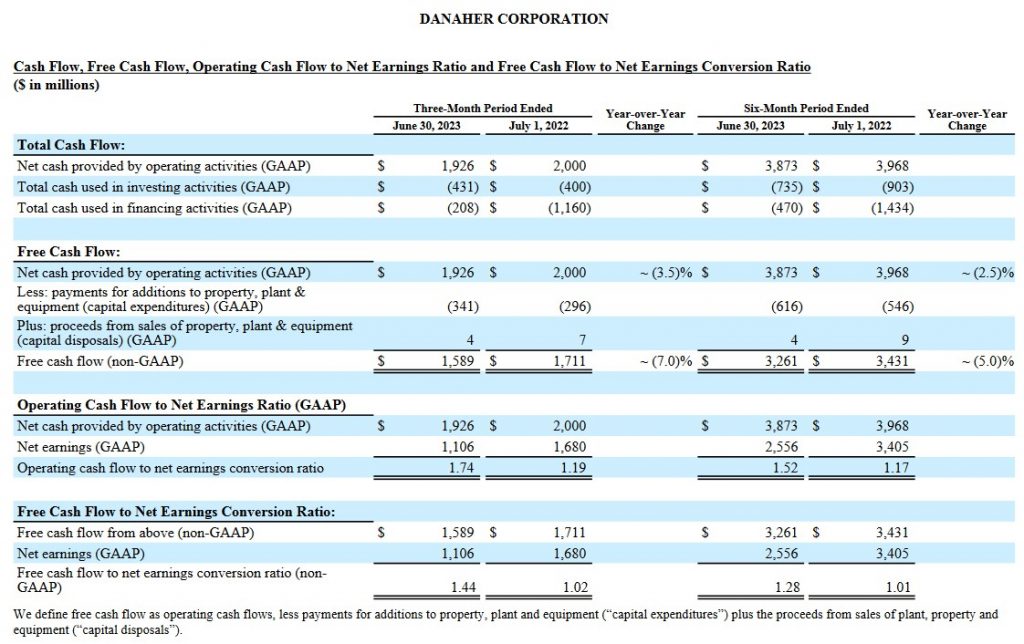
Source: DHR - Q2 2023 Reconciliation of GAAP to non-GAAP Financial Measures - July 25 2023
FY2023 Outlook
The projected reduction in Q3 and FY2023 results relative to the same timeframe in 2022 is primarily the result of lower demand for COVID-19 testing, vaccines, and therapeutics.
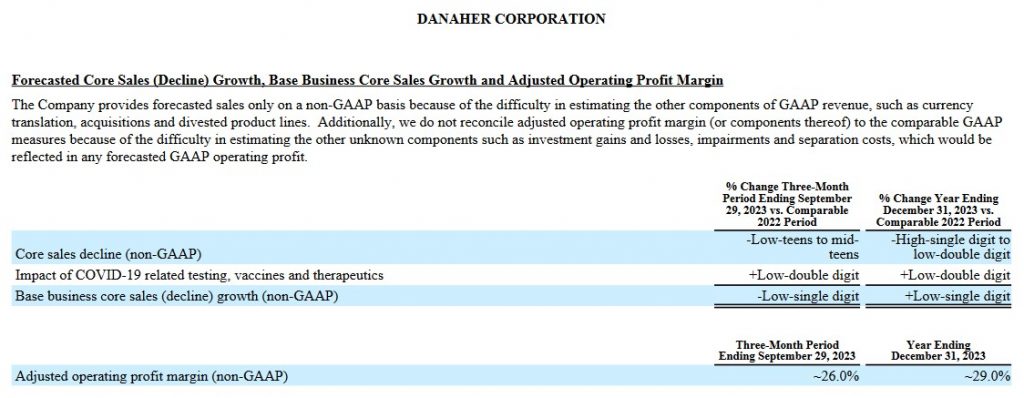
Source: DHR - Q2 2023 Reconciliation of GAAP to non-GAAP Financial Measures - July 25 2023
Credit Ratings
We see from DHR's debt schedule at the end of Q2 2023 that debt has been raised at very attractive rates. Furthermore, maturity dates are well-balanced and go far out on the calendar.
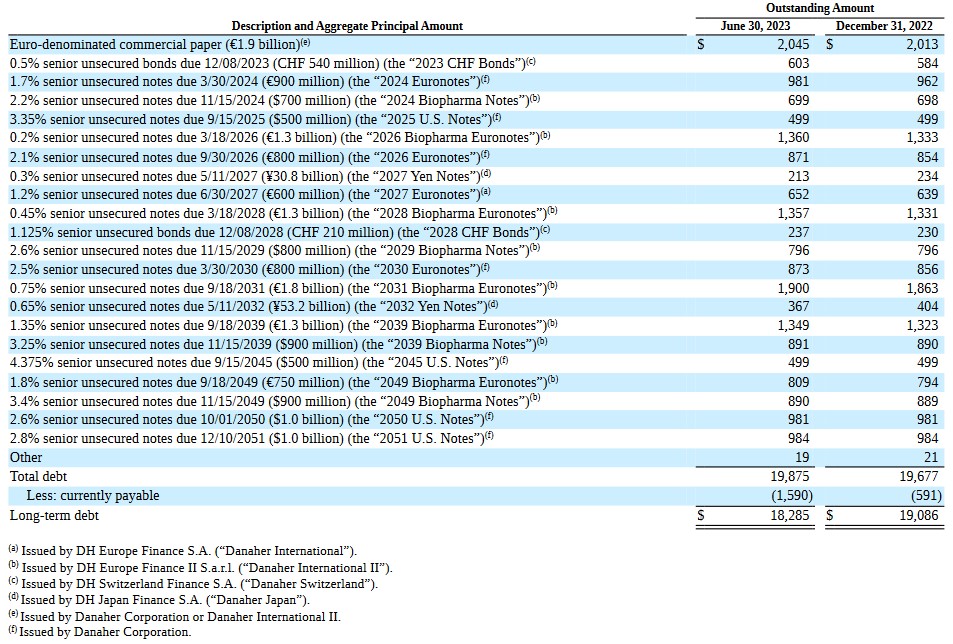
Source: DHR - Q2 2023 Form 10-Q
DHR's credit ratings are:
- Moody's: Upgraded to A3 from Baa1 on October 10, 2022;
- S&P Global: Upgraded to A- from BBB+ on June 14, 2022.
Both ratings are at the bottom tier of the upper-medium investment-grade tier. This rating defines DHR as having a STRONG capacity to meet its financial commitments. However, DHR is somewhat more susceptible to the adverse effects of changes in circumstances and economic conditions than obligors in higher-rated categories.
These ratings satisfy my conservative investment profile.
Dividend and Dividend Yield
DHR distributes a quarterly dividend. On May 9, DHR declared a $0.27 regular quarterly cash dividend, payable on July 28 to holders of record on June 30.
When I wrote my October 21, 2022 post, DHR's share price was ~$243 and the quarterly dividend was $0.25; the dividend yield was ~0.41%.
With shares currently trading at $260, the $0.27 quarterly dividend yields ~0.41%.
DHR is hyper-focused on capital allocation. The reason for the low dividend yield is that the Board feels superior long-term investor returns can be generated by retaining funds in the company.
Investors who rely on dividend income might immediately pass on DHR because of this low dividend yield. However, investors should not fixate on dividend metrics. The focus should be on total potential long-term investment returns.
On July 16, 2013, DHR's Board approved a repurchase program authorizing the repurchase of up to 20 million shares from time to time on the open market or in privately negotiated transactions. As of June 30, 2023, ~20 million shares remain available for repurchase under the Repurchase Program.
The diluted average common stock and common equivalent shares outstanding (in millions) in FY2012 - FY2022 are 713, 711, 716, 709, 700, 706, 710, 726, 719, 737, and 737. The average common stock and common equivalent shares outstanding for the 3 months ending June 30, 2023 is ~744.7.
Valuation
DHR's FY2012 - FY2021 diluted PE levels are 17.31, 21.56, 22.44, 25.80, 19.66, 27.63, 26.51, 45.41, 51.90, and 42.34. Trying to compare DHR's current valuation relative to its historical valuation is difficult because it has undergone a radical transformation over the last few years after having divested slower-growing businesses and acquiring several faster-growing businesses. As a result, comparing historical PE levels against current levels can lead to misleading conclusions.
When I wrote my October 21 post, DHR's shares were trading at ~$243. The forward-adjusted diluted PE levels were as follows based on broker earnings estimates:
- FY2022 - 21 brokers - mean of $10.53 and low/high of $10.34 - $10.77. Using the mean estimate, the forward adjusted diluted PE is ~23.1.
- FY2023 - 22 brokers - mean of $10.61 and low/high of $10.03 - $11.35. Using the mean estimate, the forward adjusted diluted PE is ~23.
- FY2024 - 15 brokers - mean of $11.61 and low/high of $10.85 - $13.15. Using the mean estimate, the forward adjusted diluted PE is ~21.
The active acquisition/divestiture of businesses distorts EPS. I, therefore, also look at DHR's Price/FCF to gauge its valuation.
DHR's FCF to net income conversion ratio has exceeded 100% for 30 consecutive years. While DHR's YTD2022 FCF from continuing operations to net earnings from continuing operations conversion ratio is only 104%, I expected the FY2022 ratio to once again exceed 1.
I anticipated that Q4 results would be relatively comparable to the first 3 quarters and the FCF to net income conversion ratio would remain at 104%. Taking the FY2022 $10.53 mean adjusted diluted EPS guidance from analysts, I multiplied this by 104% to give me $10.95 FCF/share. I then divided the $243 share price by $10.95 to give me a ~22.2 P/FCF. This was marginally superior to the FY2022 forward-adjusted diluted PE of ~23.1.
When DHR released its FY2022 results on January 24, 2023, it reported an FCF to net income conversion ratio of 102% (not 104%). Its FY2022 adjusted diluted EPS, however, was $10.95 (not $10.53). Multiply 102% and $10.95 and we get $11.17 FCF/share. Divide $243 by $11.17 and the P/FCF is 21.75 which is superior to what I projected in October.
The FY2022 results had yet to be released when I wrote my brief January 6, 2023 post at which time I disclosed the purchase of additional shares at $246.18. Using this purchase price and the current broker earnings estimates, the forward-adjusted diluted PE levels were:
- FY2022 - 24 brokers - mean of $10.56 and low/high of $10.43 - $10.77. Using the mean estimate, the forward adjusted diluted PE is ~23.3.
- FY2023 - 25 brokers - mean of $10.40 and low/high of $9.50 - $11.00. Using the mean estimate, the forward adjusted diluted PE is ~23.7.
- FY2024 - 20 brokers - mean of $11.42 and low/high of $10.85 - $12.60. Using the mean estimate, the forward adjusted diluted PE is ~21.6.
We see that my October and January purchase prices were very similar meaning DHR's valuation using P/FCF was almost identical to 21.75.
While I did not write posts to disclose my April 25 and July 6 purchases, DHR's valuation was relatively similar to that when I acquired shares on January 6.
NOTE: I place no reliance on broker estimates beyond 2023 given DHR's plan to spin off its EAS segment in Q4 2023.
In the first half of FY2023, DHR reported an adjusted diluted EPS of $4.42. If we estimate the second half of FY2023 will be somewhat similar to the first half, we should anticipate FY2023 adjusted diluted EPS of ~$8.84 (round up to $8.90). With shares trading at $260, the forward adjusted diluted PE is ~29.2.
Using current forward-adjusted diluted EPS broker estimates, DHR's forward-adjusted diluted PE levels are:
- FY2023 - 22 brokers - mean of $8.86 and low/high of $8.67 - $9.27. Using the mean estimate, the forward adjusted diluted PE is ~29.3.
- FY2024 - 21 brokers - mean of $9.70 and low/high of $8.75 - $10.23. Using the mean estimate, the forward adjusted diluted PE is ~26.8.
- FY2025 - 19 brokers - mean of $10.87 and low/high of $9.95 - $11.45. Using the mean estimate, the forward adjusted diluted PE is ~23.9.
When DHR released its Q2 and YTD2023 results, it reported a YTD2023 FCF to net income conversion of 128%. I am not entirely confident the FCF to net income conversion ratio will remain this high for the full fiscal year. I am, therefore, lowering it to 120%.
Taking the FY2023 $8.86 mean adjusted diluted EPS guidance from analysts, I multiply this by 120% to give me $10.63 FCF/share. I then divided the $260 share price by $10.63 to give me a ~24.5 P/FCF.
Final Thoughts
DHR was my 29th largest holding when I completed my Mid-2023 Investment Holdings Review. This review was completed using the June 30 closing stock prices at which time DHR's share price was ~$240.
DHR shares are currently fairly valued. However, I will bide my time in the hope of being able to acquire shares if/when they become undervalued.
I will also receive Veralto Corporation shares when the EAS business is spun off from DHR in Q4. This will be another holding requiring my analysis.
I wish you much success on your journey to financial freedom!
Note: Please send any feedback, corrections, or questions to [email protected].
Disclosure: I am long DHR.
Disclaimer: I do not know your circumstances and do not provide individualized advice or recommendations. I encourage you to make investment decisions by conducting your research and due diligence. Consult your financial advisor about your specific situation.
I wrote this article myself and it expresses my own opinions. I do not receive compensation for it and have no business relationship with any company mentioned in this article.


